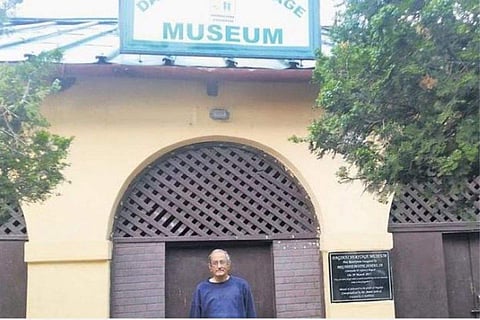
- LIFESTYLE
- FASHION
- FOOD
- ENTERTAINMENT
- EVENTS
- CULTURE
- VIDEOS
- WEB STORIES
- GALLERIES
- GADGETS
- CAR & BIKE
- SOCIETY
- TRAVEL
- NORTH EAST
- INDULGE CONNECT

Walking through the tree-lined hillside of the army cantonment of Dagshai in Solan, Himachal Pradesh, one comes across lush pine forests, winding roads and quaint cafes—features characteristic of a quintessential hill station. In the midst of this calm, however, rests a stark reminder of India’s colonial past, the Dagshai Jail Museum.
Originating from ‘daag-e-shahi’, the Persian term denoting the ‘royal mark’ that was branded on criminals during the Mughal reign, the modern town of Dagshai was founded in 1847 by Lord Robert Napier. Its remote location made it ideal for a maximum-security prison. It functioned in this capacity for nearly a hundred years. When author Anand Sethi moved to this scenic town in 2008, he found the jail unrecognisable. “It was being used as a dump yard. The site was iconic—no escapes had ever happened from here as there were three levels of gates, and a sheer cliff drop on one side. It has a phenomenal history,” says Sethi, who swiftly began championing its conversion into a museum. His dream became a reality in 2011.
With the support of the army, meticulous research conducted in India and England, and by reaching out to all the regiments that had been posted in the town, he curated a museum that captures the pre-Independence history of the jail.
A special exhibit highlights Dagshai’s Scottish connection with the Gordon Highlanders whose regimental tune remains the ‘Dagshai Hills’.
The jail housed a number of high-profile prisoners, including Gorkha mutineers after 1857, Punjabis who were incarcerated after the Komagata Maru incident of 1914, prisoners of the South African Boer war, and a group of Irish soldiers from the Connaught Rangers regiment, who mutinied against their British superiors in 1920.
Following the latter, the jail was visited by its most famous resident, Mahatma Gandhi, who voluntarily spent the night here to show solidarity with the Irish cause. His VIP jail cell was the only one to have two rooms, a fireplace and a door leading outside. In its current form, the cell bears a photograph of the Mahatma, along with a charkha to mark his presence. Decades later, the last inmate of the jail was to be Gandhi’s assassin, Nathuram Godse, who spent a night here when he was being transported to Shimla to stand trial at the High Court there in 1948.
Its status as a maximum security prison meant that the jail had many solitary imprisonment cells couched in absolute darkness, as well as a torture chamber. One of its most heinous forms of punishment, however, was revealed after the jail opened to public. “I was contacted by Alan Read, a British citizen, who told me that his grandfather had been an inmate here. His records revealed a ‘bread and water’ punishment, where the prisoner would be told to stand in a three-foot-wide enclosure between the door of the cell and iron bars out front that severely restricted movement.
They were given only bread and water for sustenance, and the punishment could be meted out for hours or days,” recounts Sethi, adding that the museum is still a work in progress. He hopes to showcase the post-Independence history of Dagshai in more rooms of the complex, which are currently locked. “We receive thousands of visitors every year, many of whom are foreigners. It shows us that this history interests people and needs to be preserved,” he says.